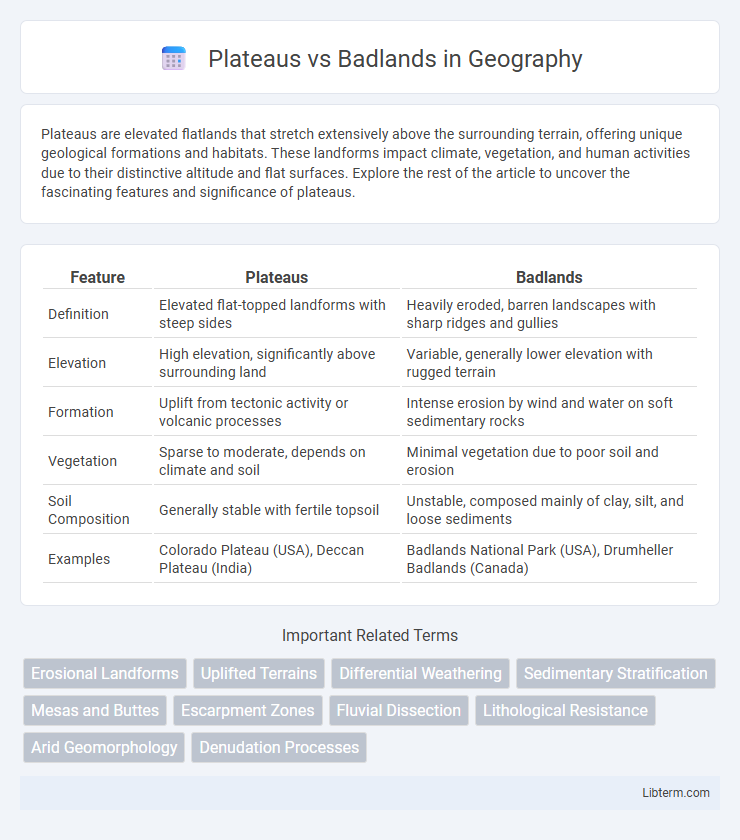Plateaus are elevated flatlands that stretch extensively above the surrounding terrain, offering unique geological formations and habitats. These landforms impact climate, vegetation, and human activities due to their distinctive altitude and flat surfaces. Explore the rest of the article to uncover the fascinating features and significance of plateaus.
Table of Comparison
| Feature | Plateaus | Badlands |
|---|---|---|
| Definition | Elevated flat-topped landforms with steep sides | Heavily eroded, barren landscapes with sharp ridges and gullies |
| Elevation | High elevation, significantly above surrounding land | Variable, generally lower elevation with rugged terrain |
| Formation | Uplift from tectonic activity or volcanic processes | Intense erosion by wind and water on soft sedimentary rocks |
| Vegetation | Sparse to moderate, depends on climate and soil | Minimal vegetation due to poor soil and erosion |
| Soil Composition | Generally stable with fertile topsoil | Unstable, composed mainly of clay, silt, and loose sediments |
| Examples | Colorado Plateau (USA), Deccan Plateau (India) | Badlands National Park (USA), Drumheller Badlands (Canada) |
Understanding Plateaus and Badlands
Plateaus are elevated flatlands formed by tectonic uplift or volcanic activity, characterized by relatively stable and expansive surfaces. Badlands, in contrast, are heavily eroded landscapes with steep slopes, irregular terrain, and sparse vegetation, created primarily through water erosion in soft sedimentary rock formations. Understanding these differences highlights how geological processes shape diverse landforms, with plateaus exhibiting structural stability while badlands reflect dynamic erosional forces.
Geological Formation Processes
Plateaus form through tectonic uplift and volcanic activity that elevate large, flat regions, while badlands develop from extensive erosion of soft sedimentary rocks such as clay and shale under arid conditions. Plateaus often feature resistant rock layers that withstand weathering, preserving their elevated flat surfaces, whereas badlands are characterized by steep slopes, gullies, and sparse vegetation resulting from rapid surface runoff and minimal soil retention. These contrasting geological formation processes highlight the interplay between deposition, uplift, and erosion in shaping diverse landforms.
Key Characteristics: Plateaus
Plateaus are elevated flat-topped landforms that rise sharply above the surrounding terrain, often formed by tectonic uplift or volcanic activity. They exhibit relatively level surfaces with steep cliffs or escarpments along their edges, and their elevation can range from hundreds to thousands of meters above sea level. Plateaus support various ecosystems due to their stable, expansive terrain, contrasting with the highly eroded and irregular surfaces of badlands.
Key Characteristics: Badlands
Badlands are defined by their highly eroded, rugged terrain characterized by steep slopes, minimal vegetation, and intricate patterns of ridges and gullies formed by wind and water erosion. These landscapes typically consist of clay-rich soil and sedimentary rock layers that create vibrant colors and striking stratification. Unlike the flat or gently sloping surface of plateaus, badlands present irregular, sharply dissected landforms with poor drainage and sparse ecosystems.
Notable Examples Around the World
Plateaus include the Colorado Plateau in the United States, the Deccan Plateau in India, and the Tibetan Plateau in Asia, known for their extensive flat-topped highlands and significant geological formations. Badlands are exemplified by the Badlands National Park in South Dakota, USA, the Drumheller Badlands in Canada, and the Bardenas Reales in Spain, characterized by their heavily eroded, rugged terrain with steep slopes and sparse vegetation. These regions demonstrate distinct geomorphological features shaped by erosion, climate, and sedimentary rock composition.
Ecological Differences
Plateaus typically support diverse ecosystems with stable vegetation, including forests and grasslands, due to their elevated flat terrain and moderate soil stability. Badlands feature sparse vegetation and harsh, erosion-prone soils that create unique habitats for specialized, drought-resistant species. The contrasting soil composition and moisture availability drive distinct ecological communities adapted to either stable or rapidly changing environments.
Erosion and Weathering Impact
Plateaus, characterized by their elevated flat tops, undergo erosion primarily through weathering processes such as wind, water, and temperature fluctuations that gradually wear down the rock layers. In contrast, badlands exhibit intense erosion with deeply dissected terrain formed by rapid surface runoff and sparse vegetation, which accelerates weathering and sediment removal. The differential erosion rates in badlands result in unique landforms like sharp ridges and gullies, while plateaus maintain relatively stable surfaces despite long-term weathering impacts.
Human Interaction and Usage
Plateaus provide fertile grounds for agriculture and settlement due to their relatively flat terrain and stable climate, supporting human communities and infrastructure development. Badlands, characterized by eroded, rugged landscapes, limit agricultural practices but attract tourists and researchers interested in geology and paleontology. Human interaction with plateaus often involves farming, grazing, and urbanization, while badlands mainly support conservation efforts and educational activities.
Tourism and Cultural Significance
Plateaus attract tourists with expansive landscapes offering hiking, rock climbing, and panoramic views, often hosting indigenous cultural sites and ancient traditions preserved by local communities. Badlands captivate visitors through their unique erosional features, fossil beds, and dramatic terrain, which provide insights into prehistoric ecosystems and indigenous lore. Both landforms hold significant cultural heritage, where tourism supports conservation efforts and educates the public on environmental and historical importance.
Comparing Plateaus and Badlands
Plateaus are elevated flat-topped areas that rise sharply above surrounding terrain, usually formed by tectonic uplift or volcanic activity, while badlands consist of heavily eroded, barren landscapes with steep slopes and minimal vegetation, shaped primarily by water erosion on soft sedimentary rocks. Plateaus exhibit more stable landforms with relatively gentle slopes and vast expanses, in contrast to the sharply dissected, rugged topography and intricate drainage patterns characteristic of badlands. The climatic conditions and underlying geology play crucial roles, with plateaus often found in arid or semi-arid regions but retaining more soil cover, whereas badlands are typically exposed due to rapid erosion processes.
Plateaus Infographic

 libterm.com
libterm.com